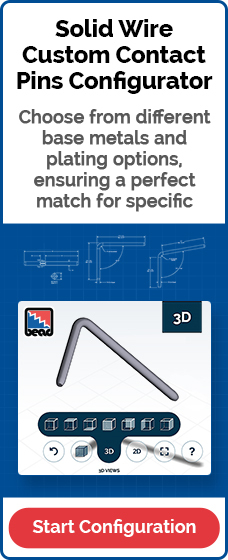Custom electronic pins can be manufactured in multiple ways, including swaging or machining. Each method has its advantages and disadvantages. In this article, we’ll cover the unique properties of each method so you can make an informed decision about which method is right for you.
What is Swaging?
Swaging is a unique cold-forming process that starts when a continuous metal strip is pulled through a precision-engineered draw die to form a seamed tube. Tube diameters are then reduced in progressive forming cavities and then separated from the tube. It is a high-speed, virtually scrapples process where metal is moved and not removed. It’s capable of producing small, tubular metal components that are dimensionally consistent as well as inexpensive. This process can also be used with round or square wire, as well as loose or continuous wire pins.
Key Benefits of Swaging:
- Cost-effective, high speed
- Highly scalable/repeatable process
- Uses less material
.png?width=1200&height=628&name=Bead%20Potential%20Blog%20Images%2062624%20(1).png)
What is Machining?
Machining involves feeding metal rods through a turning press producing loose piece interconnect pins and contacts. This process creates a lot of metal scrap which adds cost to this fabrication option.
Key Benefits of Machining:
- Versatility
- Tight tolerances
- Ability to handle complex designs
Swaging vs Machining: A Comparison
When deciding which method is right for your project, you’ll want to consider these factors:
Cost Efficiency: Swaging offers a cost-effective solution with a shorter turnaround time, especially for large volume runs. Machining on the other hand, produces more material waste and takes more time, which means higher costs.
Material Usage: Swaging minimizes material waste through compression and forming, while machining typically involves significant material removal and waste. Swaging can also save you between 40-80% on material costs, depending on the material.
Precision and Tolerances: Swaging is highly precise for certain shapes and pin geometries. Machining also offers extremely tight tolerances but may require multiple steps.
Durability and Strength: Swaged pins often have enhanced strength due to cold-working processes. The strength of machined pins is more dependent on the base material's properties.
When to Use Swaging
- Reducing rods, wires, and tubes
- Remodeling existing products
- Sizing and shaping new components
- When lighter components are needed
- High volume production scenarios
- Tight timeline and/or budget
- PCB applications
When to Use Machining
- Complex geometries
- Custom parts with tight tolerances
- Prototyping
- When heavier components are needed
Why Bead Uses Swaging
Bead Electronics has been using swaging to manufacture custom pins since 1920.It’s an innovative approach to an old manufacturing process with many benefits. Swaging allows us to produce high-quality, high-precision pins at a fraction of the cost of their machined counterparts in as little as two weeks. For instance, Bead’s hollow pins can be 63% of the weight of a solid machined pin but look identical and have the same mechanical and electrical performance.
Learn more about our swaging process, we’ve been using for over 100 years!



